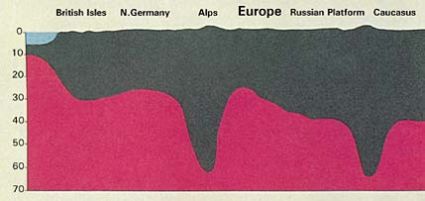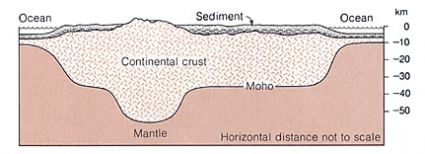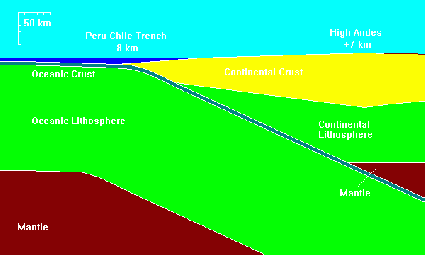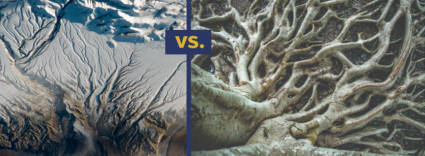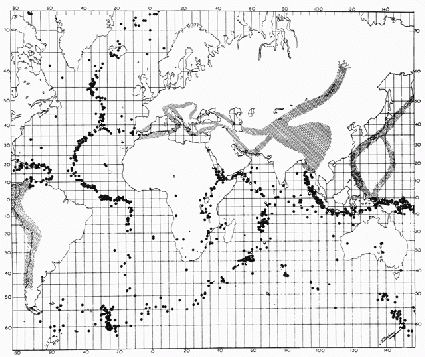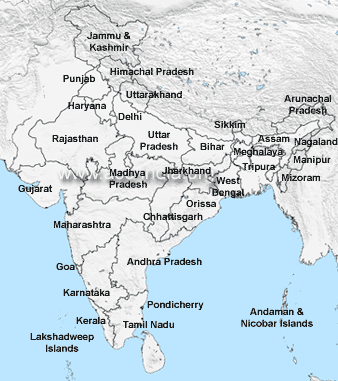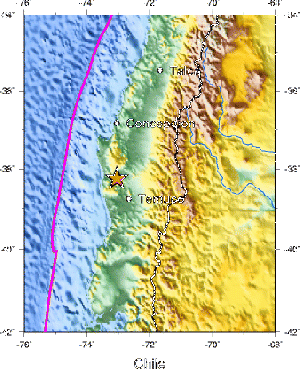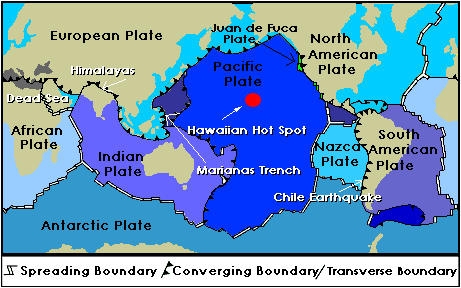The Quran and Mountains: Difference between revisions
| [unchecked revision] | [checked revision] |
mNo edit summary |
(Added new material, and deleted the old material which was unnecessarily making the article long.) |
||
| Line 24: | Line 24: | ||
Moreover, the critics claim that the writer of Quran made two scientific mistakes regarding the creation of mountains. | Moreover, the critics claim that the writer of Quran made two scientific mistakes regarding the creation of mountains. | ||
=== | ===First Mistake: Allah 'placed جعل' the Mountains 'from above من فوقها' into the earth according to the Quran=== | ||
According to the modern science, mountains are formed when two plates tectonic collide with each other, and thus the mountains rise '''from within''' the earth. | According to the modern science, mountains are formed when two plates tectonic collide with each other, and thus the mountains rise '''from within''' the earth. | ||
| Line 67: | Line 67: | ||
Moreover, there are other type of mountains too, which are formed when Lava comes out from inside the earth. When this lava cools down, it forms high and big mountains, which are known as [http://www.universetoday.com/29833/how-mountains-are-formed/ Volcanic Mountains]. | Moreover, there are other type of mountains too, which are formed when Lava comes out from inside the earth. When this lava cools down, it forms high and big mountains, which are known as [http://www.universetoday.com/29833/how-mountains-are-formed/ Volcanic Mountains]. | ||
=== | ===Second Mistake: Allah had already made the mountains on the day of Sunday at time of the creation of the universe=== | ||
Quran claims that Allah had already created the mountains on the 2nd day of creation. | Quran claims that Allah had already created the mountains on the 2nd day of creation. | ||
{{Quote|1=[https://quranx.com/41.9?context=4 Quran 41:9-11]|2=Say, "Do you indeed disbelieve in He who created '''the earth in two days''' and attribute to Him equals? That is the Lord of the worlds. '''And He placed on the earth firmly set mountains over its surface''', and He blessed it and determined therein its [creatures'] sustenance in (next) four days without distinction - for [the information] of those who ask. Then He directed Himself to the heaven while it was smoke and said to it and to the earth, "Come [into being], willingly or by compulsion." They said, "We have come willingly."}} | {{Quote|1=[https://quranx.com/41.9?context=4 Quran 41:9-11]|2=Say, "Do you indeed disbelieve in He who created '''the earth in two days''' and attribute to Him equals? That is the Lord of the worlds. '''And He placed on the earth firmly set mountains over its surface''', and He blessed it and determined therein its [creatures'] sustenance in (next) four days without distinction - for [the information] of those who ask. Then He directed Himself to the heaven while it was smoke and said to it and to the earth, "Come [into being], willingly or by compulsion." They said, "We have come willingly."}} | ||
| Line 81: | Line 81: | ||
*And older mountains erode and disappear with time, and new mountains start forming. | *And older mountains erode and disappear with time, and new mountains start forming. | ||
==== Islam advocates: The days of creation with Allah were different than days on the Earth and are of 'unspecified' period of time ==== | ====Islam advocates: The days of creation with Allah were different than days on the Earth and are of 'unspecified' period of time==== | ||
Islam advocates claim<ref>[https://web.archive.org/web/20201103111946/https://www.dar-alifta.org/Foreign/ViewFatwa.aspx?ID=8031]</ref>: | Islam advocates claim<ref>[https://web.archive.org/web/20201103111946/https://www.dar-alifta.org/Foreign/ViewFatwa.aspx?ID=8031]</ref>: | ||
* The days of creation with Allah are different than the earth. | *The days of creation with Allah are different than the earth. | ||
* Thus those 6 days were of '''unspecified''' period of time. | *Thus those 6 days were of '''unspecified''' period of time. | ||
* Allah didn't tell the length of that period, as humans are unable to '''comprehend''' it. | *Allah didn't tell the length of that period, as humans are unable to '''comprehend''' it. | ||
The Critics of Islam answer that claim of "unspecified time" is false, as the writer of the Quran described the '''specified time''' in the following verses: | The Critics of Islam answer that claim of "unspecified time" is false, as the writer of the Quran described the '''specified time''' in the following verses: | ||
| Line 214: | Line 214: | ||
The above and similar studies are referenced by advocates as specific evidence of mountains stabilizing the Earth's crust and undermining seismic activity. Critics respond that although the phenomenon described has a limited stabilizing effect on certain regions favorably positioned vis-à-vis the mountain range, the mountains do not prevent the earthquake outright and, more importantly, that the limited stabilizing effect observed is only relevant if the inhabited area happens to be favorably positioned vis-à-vis the mountain range - this means that if, for instance, the city were located between the mountain and the fault line where the quake originated, even if the city was located near the foot of the mountain, then the destruction experienced by the city would not be reduced in any significant way. Critics have also stated that the dampening effect described above although real in some cases, is, yet again, not a phenomenon that can be described in any plausible way as being peg-like. | The above and similar studies are referenced by advocates as specific evidence of mountains stabilizing the Earth's crust and undermining seismic activity. Critics respond that although the phenomenon described has a limited stabilizing effect on certain regions favorably positioned vis-à-vis the mountain range, the mountains do not prevent the earthquake outright and, more importantly, that the limited stabilizing effect observed is only relevant if the inhabited area happens to be favorably positioned vis-à-vis the mountain range - this means that if, for instance, the city were located between the mountain and the fault line where the quake originated, even if the city was located near the foot of the mountain, then the destruction experienced by the city would not be reduced in any significant way. Critics have also stated that the dampening effect described above although real in some cases, is, yet again, not a phenomenon that can be described in any plausible way as being peg-like. | ||
==See Also== | ==See Also== | ||
Revision as of 20:48, 18 October 2021
This article or section is being renovated. Lead = 3 / 4
Structure = 3 / 4
Content = 4 / 4
Language = 4 / 4
References = 3 / 4
|
Modern Islamic Scholars claim that modern science has proved that roots of mountains go inside the earth like pegs, therefore it is a miracle of Quran to tell it correctly 1400 years ago.
While the critics not only deny it to be a miracle of Quran, but also claim that Quran made two scientific mistakes about the mountains.
Advocate's claim: Quran rightly told 1400 years ago that mountains works as pegs/anchors in order to stabilize the otherwise shaking earth
They quote the following verses as a proof.
And We made on the Earth stabilisers (i.e. Mountains), so that it would not tumble with you.
Please also see the verses 15:19, 16:15, and 31:10
The idea of Mountains being Pegs had already existed among the Arabs before Muhammad
The idea of mountains being pegs even existed among the Arabs before Muhammad. For example, Ka’ab was one of the ancestor of Muhammad. This Ka’ab also declared mountains to be pegs long before Muhammad.
Ka'ab Bin Lowy was a man of great honour among his ancestors and progeny. He was the first person who gave the name of Friday to the day of Friday. Arabs used to call him 'Aroba. He gathered them and advised them to hear, learn and understand, and to know that night is deserted and silent, while day is full of sunlight, and earth is a cradle while sky is a support, and mountains are pegs, and stars are signs, ...
Similarly, other civilizations also had the concept of mountains having roots. For example, we find this concept in bible too.
Thus, the critics point out that it could not be a miracle of Quran, but it recorded only an old concept.
There are 2 Scientific mistakes in Quran regarding the creation of mountains
Moreover, the critics claim that the writer of Quran made two scientific mistakes regarding the creation of mountains.
First Mistake: Allah 'placed جعل' the Mountains 'from above من فوقها' into the earth according to the Quran
According to the modern science, mountains are formed when two plates tectonic collide with each other, and thus the mountains rise from within the earth.
But the Quranic verse 41:10 claimed that Allah 'placed' the mountains 'from above' into the earth.
وَجَعَلَ فِيهَا رَوَٰسِىَ مِن فَوْقِهَا
And He placed (Arabic: جعل) in it stabilisers (i.e. mountains) from above (Arabic: من فوقها).(Quran Word by Word Translation by Quran Corpus)
And He placed therein firmly-set mountains from above it. (Word for Word Dr. Shehnaz Shaikh)
And He made in it mountains above its surface. (Shakir)
And He made on it firm mountains from above it. (Dr. Laleh Bakhtiar)
He has placed in it (the earth) firm mountains from above it. (Abdul Hye)
And He placed therein firm mountains from above it. (Dr. Kamal Omar)
And He made therein anchorages (i.e., mountains) from above it. (Muhammad Mahmoud Ghali):
And He placed on the earth firmly set mountains over its surface. (Sahih International)
And He placed in it stabilizers from above it. (The Monotheist Group)
And He made/put in it anchors/fixtures/mountains from above it. (Muhammad Ahmed - Samira)
And in it He placed mountains as anchors from above it. (Faridul Haque)
He placed therein (i.e. the earth) firm mountains from above it. (Mohsin Khan & Muhammad al-Hilali)
Similarly, verse 16:15 is also telling the same thing that Allah CASTE the mountains into the earth.
(Sahih International) And He has cast into the earth firmly set mountains, lest it shift with you,
The word 'he has cast' is alqa (lam-qaf-ya), which in this form (Arabic verb form IV) is frequently used elsewhere in the Quran to mean throw or cast. It is the same word as is used in Quran 3:44 when lots are cast using pens (it would be easy to imagine that mountains were similarly scattered), and Quran 12:10 when the prophet Yusuf is cast down into the well, and in Quran 20:20 when Moses casts down his staff, which becomes a snake.
According to the modern science, mountains are not 'placed'/'cast' over earth's surface, but they are formed when two plates tectonics collide with each other (i.e. when earthquake takes place), then crust of one plate goes upwards and forms a mountain, while the crust of other plate goes downwards.
And then this process of colliding of plates tectonics (i.e. earthquakes) continues for millions of years, and with each collision mountains keep on rising high little by little. And when the plates tectonics start to move away from each other, then these high mountains start to erode and after millions of years, they completely disappear.
For example, there existed no Mount Everest 250 million years ago. But then two plates tectonics collided with each other, and a small Mount Everest came into being due to that. Then it kept on gaining height with each collision of the plates tectonics. Today it is the highest mountain. It will keep on gaining even more height, but then a time will come, when it will start eroding and will disappear completely.
Moreover, there are other type of mountains too, which are formed when Lava comes out from inside the earth. When this lava cools down, it forms high and big mountains, which are known as Volcanic Mountains.
Second Mistake: Allah had already made the mountains on the day of Sunday at time of the creation of the universe
Quran claims that Allah had already created the mountains on the 2nd day of creation.
And Hadith made it more clear that 2nd day of creation was Sunday, when the mountains were created by Allah.
But according to the modern science[1][2]:
- Mountains had not already been created on the 2nd day of creation of the heavens (universe) and the earth.
- But earth came into being 9 billion years after the heavens (universe).
- And the earth initially consisted of gases and molten surface only. It took billions of more years to come into solid form.
- And even after earth had already come into solid state, still it took billions of years more in the formation of plates tectonics and then mountains.
- And older mountains erode and disappear with time, and new mountains start forming.
Islam advocates: The days of creation with Allah were different than days on the Earth and are of 'unspecified' period of time
Islam advocates claim[3]:
- The days of creation with Allah are different than the earth.
- Thus those 6 days were of unspecified period of time.
- Allah didn't tell the length of that period, as humans are unable to comprehend it.
The Critics of Islam answer that claim of "unspecified time" is false, as the writer of the Quran described the specified time in the following verses:
Thus Sahaba (i.e. companions) believed in it that one day of creation was equal to 1000 years of our reckoning.
Ibn Kathir writes under the commentary of this verse 22:47:
But modern science told us that creation of universe took billions of years. Therefore, even if we consider 1 day of Allah is equal to 1000 years of our reckoning, still 6 days make only 6000 years of creation, which stays contradictory the modern science.
Discussions regarding the proposed miracle
Isostasy and mountains as peg-like structures
Schematic from Cailleux's Anatomy of the Earth
The schematic diagram taken from page 220 of Anatomy of the Earth by the French geologist Cailleux is cited by various sources advocating the reality of the proposed miracle.[4] The basic underground protrusion of the crust beneath the mountainous region of the Alps, for instance, appears as a sort of peg embedded in the lower layer of the Earth. This, the advocates suggest, coheres nearly with Quran 78:6-7 which reads, “Have We not made the earth as a wide expanse, And the mountains as pegs?”
The geological phenomenon observed is known as isostasy. This term describes the nature of the Earth's crust such that the height of the crust above the layer of the Earth immediately beneath the crust tends to be proportionate to the depth of the crust into the lower layer in the same area.
Thus, elevation above sea-level tends to correlate positively with the thickness of the Earth's crust at any given place. The reason why the crust tends to exist in this manner is compared to the same physics of floatation whereby the majority of an iceberg suspended in water extends below sea level and, at the same time, it is the case that the taller the portion of ice above sea level, the deeper the iceberg dips down below.
Advocates of the scientific miracle argue that isostasy affirms the peg-like nature of mountains and that Muhammad could not, in the 7th century, have come to realize this without divine aid. Critics respond to this by arguing that the caption associated with the diagram found in Cailleux's book explicitly points out that the visual representation has had its 'vertical scale greatly exaggerated'.[5] As a result, critics argue, the peg-like nature of mountains is not so plainly evident as the exaggerated representation found in the diagram would make it seem.
Accurate representations of isostasy and exceptions
Other visual representations with less exaggerated and more accurate vertical scales, some of which are cited by the advocates themselves, do not depict mountains as so plainly resembling pegs.[4] Advocates respond by suggesting that when viewed in this more accurate representation, the mountains resemble 'blunt pegs'; critics disagree.
Critics hold that the 'roots' of the mountains described by isostasy do not resemble pegs in either form or function. For instance, isostasy, while often observed, is by no means universal and there are several outstanding examples of mountains and other elevated geological structures which have no such roots.
Examples include structures formed by the geological processes of extension and faulting, such as the Nevada Basin and Range, as well as those formed thrust and fold belts, such as the Appalachians, Eastern Bolivian Andes, Zagros Mountains, and the Calcareous Alps. Indeed, even the Himalayas are underlaid by a crust structure shaped like a broad wedge and which does not resemble a peg.[6] The same is true for the Pyrenees.[7]
Another important example is the Andes mountain range, whose 'roots', as observed in a true-scale cross-section of the range, do not resemble a peg and which do not serve any 'peg-like' purpose.
Critical and historical perspectives
Critics conclude that what may at most be said regarding the roots of those mountains that possess them is that they resemble pigs in some minimal metaphorical sense and that it is not the case that all mountains are literal pegs, as described in the Quran, which have been 'cast down' into the earth in order to stabilize this.
If the advocates opt to transition to a metaphorical interpretation here, the critics continue, they have made an arbitrary decision, as the relevant scripture appears to take its own description quite literally (as is generally the case with verses in the Quran describing the step-wise creation of the Earth and heavens).
Historians circumvent the debate and simply hold that since there is no reason to believe that Muhammad was receiving revelation from some deity, or even that such a deity exists, Muhammad likely either inferred the existence of some subsurface structure beneath mountains on the basis of basic visual comparisons between the side of a mountain and the bottom of a tree or adapted the beliefs of predecessors who had made such observations before his time.
Historians point out, for instance, that the ancient Hebrews held similar ideas regarding the 'roots of mountains'. It is not at all inconceivable and to some extent certain that such ideas had been passed down to and adapted by Muhammad.
The function of pegs vs. that of mountains
General arguments
Some advocates of the miracle argue that where mountains result from the collision of tectonic plates, they also cause the stability of the Earth. One advocates of the miracle writes as follows:
Critics, in response, point out the difference between cause and effect, suggesting that the advocates conflate the two, and describe how the formation of mountains is an incidental result of the collision of the tectonic plates, an event which in fact causes rather than prevents earthquakes. The mountains generated at these fault lines are a product of the tectonic collision and cannot be said to in any sense prevent it from taking place.
Other advocates of the miracle, aware that these mountains result from and do not prevent tectonic collision, proceed differently. These advocates argue that the mountains slow the collision down and dampen the impact.
To these advocates, critics respond that there is no scientific evidence which suggests that mountains slow down tectonic collisions in any meaningful way. And, while it is inevitably the case that the crumpling of the crust which forms the mountains throughout the collision somehow 'dampens' the impact, there is no evidence that the resultant mountains stabilize either plate (it is also difficult to interpret what this could possible mean, as the mountains do not exist prior to the collision in any case, and so could not, again, meaningfully 'prevent' it). What stops the collision are simply the opposing forces of either plate.
Moreover, the critics add, considering the above, these mountains are not acting in any capacity that can be described as peg-like (a better analogy might be the bumper of a car, which crumples upon collision to save the driver, for instance, from being crumpled - but this has nothing to do with pegs and does not serve the purpose of 'stabilization').
Arguments presented by Professor El Naggar
Professor El Naggar presents the above arguments in fewer words and with a less detailed explanation.
Critics have responded to El Naggar's argument by equating it with the common argument made by advocates of the miracle which conflates the causality and effects involved in the collision of tectonic plates. The mountains, the critics repeat, are the product of the collision and play no known role in stopping it. The collision of the plates stops, instead, gradually slows down as a result of the opposing forces of the two colliding plates.
Critics also point out that El Naggar provides no reference for the causal connection he presents, and that the unevidenced claim presented here by El Naggar is itself only cited by un-refereed conferences on so-called 'Islamic science'.[9] El Naggar's own body of research contains nothing that would support the claim, which is perhaps unsurprising, as El Naggar's own specialization is in biostratifaction and not in the supposed 'stabilizing role of mountains'.
Interestingly, the respected and much more widely-published geologist Dr. David A. Young reportedly concluded precisely the opposite of what El Naggar suggests, differentiating between the mountains existence as a product of the collision and any supposed role they might be assumed to play in rendering the crust stable. It is perhaps important to note that, by stark contrast, none of El Naggar's scientific publications have been peer-reviewed.
El Nagger also suggests that mountains stabilize the lithospheric plates by sinking into the asthenosphere.
As above, there is no scientific evidence which demonstrates that mountains stabilize the lithospheric plates, and El Naggar provides no references. By contrast, there is scientific evidence that suggests that continental plates are stabilized by craton keels. Craton keels are deep extensions of cratons into the mantle which extend any where from 60-300km below the surface. These keels extend far deeper than mountain roots. The formation of these craton roots, or keels, is, however, unrelated to mountains or their formation.[11]
Critics also point out that cratons are stable regions of the earth's crust that are no longer subject to mountain building processes. These craton roots or keels form through the depletion of basaltic elements into the asthenosphere, leading to less dense material that sinks deeper into the mantle due to the lower buoyancy (i.e. the isostasy of the crust, that is, rather than of the mountains).[12]
The relationship between mountains and earthquakes
Critics also point out that, as early as the 1920s, scientists noted that earthquakes are concentrated in very specific and narrow zones arounds the planet (known as Wadati-Benioff zones). In 1954, French seismologist J.P. Rothé published a map showing the concentration of earthquakes along the zones indicated by dots and cross-hatched areas.[13]
Critics note how the earthquakes originate mainly from the edges of tectonic plates, including collisional mountain ranges and ocean trenches and ridges, which demonstrates that mountains do not stabilize the crust or the earth. The presence of mountains on any part of the Earth's surface thus often suggests the presence of precisely those underground geographical circumstances which generate earthquakes.
Critics cite the Himalayan mountain range as a specific example of a mountain range which, rather than preventing earthquakes, is in fact closely associated with them. The collision of tectonic plates causes mountains to form and this same collision also causes earthquakes, which explains the correlation of the two phenomena.
ASC India
Indeed, a mountainous region is often indicative of a high-earthquake frequency in the same area. Other examples of mountainous regions that are high-frequency earthquake zones include the Andes[14] and the African mountains.[15]
Amateur Seismic Centre
Many of the the largest earthquakes, including the two largest earthquakes ever recorded, are associated with mountainous regions.[16] The largest earthquake was the great Chilean earthquake, which occurred 140km south-south-west of Concepción (Biobio), Chile, registered at 9.5Mw – the Andes mountain range, evidently, did not prevent the earthquake or cause the region to be particularly stable.
The second largest earthquake was the Prince William Sound earthquake, which occurred 33.2km SE of Mt. Goode (Alaska), U.S.A., registered at 9.2Mw – Mt Goode, nearby, was of no assistance. The sixth largest earthquake was the Ecuador earthquake, which occurred 138km west of Tortuga (Esmeraldas Province), Ecuador, registered at 8.8Mw – the nearby Andes mountain range was likewise of no assistance. The eighth largest earthquake was the Arunachal Pradesh, which occurred 20.7 kilometers NW of Tajobum (Arunachal Pradesh), India, registered at 6Mw – this earthquake took place in the Assam hills and caused landslides in the mountains which, again, did not prevent or stabilize the earthquake. Such examples where formidable mountains and mountain ranges co-exist with earthquakes of immense magnitudes, critics point out, are abundant and thus undermine the idea that mountains stabilize the Earth or play any role in mitigating earthquakes.
Critics point out the largest earthquake ever recorded - the Chilean earthquake in 1960 - in particular. The U.S. Geological Survey had the following to say regarding this earthquake:
1960 May 22 19:11:14 UTC
Magnitude 9.5
The Largest Earthquake in the World
More than 2,000 killed, 3,000 injured, 2,000,000 homeless, and $550 million damage in southern Chile; tsunami caused 61 deaths, $75 million damage in Hawaii; 138 deaths and $50 million damage in Japan; 32 dead and missing in the Philippines; and $500,000 damage to the west coast of the United States.
U.S. Geological Survey, March 29, 2010
The Andes Mountains did not prevent or stabilize this earthquake. On the contrary, later research revealed that the collision of tectonic plates that caused the earthquake also caused the Andes mountains to be raised. Similar earthquakes in the past are responsible for the existence of Andes in the first place. This collision even serves as a textbook example of the general phenomena, as can be seen below.
Earth Science From Moorland School
Mountains and isostatic stabilization
Advocates of the miracle point to George Airy's model of isostasy, which supports the idea that isostasy occurring below mountains causes mountains themselves to be more stable than if isostasy were not occurring below. This, they argue, is another point of evidence that mountains stabilize the Earth as described in the Quran. Critics respond to this argument by stating that George Airy's model says nothing special of mountains, per se, and simply demonstrates that isostasy - that is the extension of the earth's crust below the surface to a degree correlated to the height of the surface at any given point - generally causes the crust of the earth to be stable, whether or not a a given area is mountainous. Moreover, they point out, the fact that a mountain's isostasy causes the mountain to stabilize 'itself' - that is, just as the isostasy of any region causes that same region to be stable - does not mean that the mountain is in any way stabilizing the Earth in general or even the surrounding region in any meaningful way. They summarize this counterargument by suggesting that, on the basis of Airy's model, it can be said that if there were a region possessing a mountain and subject to isostasy, there is no reason to believe that region would be more stable than another, similar region that did not have a mountain but was also subject to isostasy to the same, natural extent.
David Smith, Director of Professional Development, MadSci Network, Earth Sciences, March 14, 2004
Another way the critics put it is that the phenomenon of isostasy is itself responsible for the stability of the crust - whether or not the crust is host to mountains in any given region. Isostasy stabilizes mountains, even terrain, and even indented regions on the Earth's surface. The Mountains do not cause this isostasy any more than isostasy causes mountains, as isostasy is co-occurrent with any variety of terrain - mountainous or otherwise. The co-occurrent isostasy is, however, responsible for the stability of the mountains as well as the crust, and not the other way around - that is, a region excepted from the norms of isostasy (as many are) will not be as stable, whether this region is mountainous or not. Isostasy is best understood as a phenomenon separate from the mountains altogether, as it is no more bound in the simple fact of its existence to the presence of mountains than it is to region of simple, flat crust (even if the specific form it takes in either of these cases is).
Earthquakes and the meaning of tameeda and zalzala
In response to the regular co-occurrence of earthquakes and mountains due to their related presence at tectonic fault-lines, advocates of the miracle sometimes argue that the word (tameeda) used in the Quran to describe the phenomenon which mountains, as pegs, prevent describes something altogether different from earthquakes. What this phenomenon is, they suggest, is not known, as it has not been observed, which may be due to the fact that it does not take place on a human timescale but rather, perhaps, a geological timescale (that is, over hundreds of thousands or millions of years). The argument is based upon the alternative meanings that the word tameeda can have, including 'stagger', 'roll', 'sway', and 'tilt', along with the idea that any geological phenomenon described by these alternative meanings of the word tameeda would be distinct from the short, sharp shock of an earthquake. This, the advocates hold, is important because the Quran deliberately opts not to use the word zalzala in these contexts, which is used elsewhere in the Quran to describe earthquakes.
The phrase tameeda bi- (from mada, yamidu) is only used in Quran 31:10, Quran 21:31, and Quran 16:15.
Lane's lexicon defines this usage as 'Lest it (the earth) should be convulsed with you, and go round with you, and move you about violently. (El-Basáïr, TA.)'.[17] The other usages given by Lane which involves the bi- prefix are for mada bihil bahr (مَادَ بِهِ البَحْرُ), which means 'The sea affected him with a heaving of the stomach, &c. (L.)' and madat bihil ard (مَادَتْ بِهِ الأَرْضُ), which means 'The ground went round with him. (A.)'.[18]
Critics point out that all usages of the word tameeda that subsequently involve the bi- prefix (which means 'with') denote an effect upon humans. While other, not-human-related usages of words deriving from the root mada exist, the word tameeda followed by the prefix bi- always involves human beings. This, alongside the fact that two of the three verses using the phrase affix the bi- prefix with the -kum pronoun (which means 'you all'), makes it clear that whatever the Quran is describing here is somehow immediately relevant to humans and that humans are subject to it. Critics thus conclude that it makes no sense to assume that the Quran is here alluding to some phenomenon unknown to humans, as this interpretation is permitted neither by rational discussion, which requires the possibility of falsification, nor the constraints of the Arabic language. A useful analogy for the comparison between the words tameeda and zalzala, critics suggest, is the difference between the English phrases 'seismic activity' and 'earth tremors'.
Some critics add that, perhaps even more importantly, that where the Quran uses the word zalzala to describe a geological phenomenon, it does so only in the context of the divine acts of destruction that will precede the Day of Judgement. This is different from the verses using the word tameeda, which describe what would presently be taking place on Earth is God had not set the mountains down as stakes (that is, supposedly, common earthquakes).
In addition to the arguments presented by the critics themselves, critics point out that key authorities in the Islamic interpretive tradition have explicitly identified the word tameeda and the verses it is used in as describing earthquakes of the sort that are experienced by human beings. One such key classical authority, a specialist in the interpretation of the Quran, was Ibn Kathir.
Tafsir Ibn Kathir
A final point critics have made in this vein is that if it is the case that the phenomenon described as tameeda occurs on geological timescales imperceptible to humans, then it is difficult to see how mountains, which repeatedly form and disappear on geological timescales, could be responsible for the sustained stabilization of the planet's surface (the Earth having existed for some 4.5 billion years). Moreover, they close, if some such phenomenon was taking place on a geological timescale unbeknownst to humans, why would the Quran mention this? Surely, God would not intentionally speak of things that are incomprehensible to humans, as that would be absurd. At the very least, if the phenomenon described exists but is unknowable, and the Quran is not here making a simple scientific error in its assertions, then what these verses contain cannot be verified as a scientific miracle, for humans, in this case, have no way of verifying what the verses speak of.
Mountains and stabilization of the Earth about its axis
Some advocates of the miracles argue that while mountains do not directly stabilize the Earth's surface by functioning as pegs, their presence and the concomitant fact of the crust being thicker at certain locations due to isostasy results in an increased moment of inertia for the earth, thus reducing its rotational speed and axial tilt. Critics respond to this argument by pointing out that the relative impact of the denser crust at the locations of some mountains is infinitesimally small simply because the crust, even where it is thicker, weighs astronomically less than the Earth as a whole, which weighs 5.97*1024 kgs, such that it has no significant impact on the Earth's rotational speed or axial tilt. While scientists have acknowledged the extremely minimal impact of the mountainous crust in these respects, they have also pointed out that the Earth's rotational speed and axial tilt are more impacted by small factors such as the Earth's distance from the moon and even by the ancient effect of the post-glacial rebound since the ice ages than they are by the mountains.
Critics also argue here that it is nearly impossible to correlate this stabilization effect, how minimally real it may be, with any remotely plausible interpretation of the relevant verses.
Mountains and the absorption of seismic earthquake waves
The above and similar studies are referenced by advocates as specific evidence of mountains stabilizing the Earth's crust and undermining seismic activity. Critics respond that although the phenomenon described has a limited stabilizing effect on certain regions favorably positioned vis-à-vis the mountain range, the mountains do not prevent the earthquake outright and, more importantly, that the limited stabilizing effect observed is only relevant if the inhabited area happens to be favorably positioned vis-à-vis the mountain range - this means that if, for instance, the city were located between the mountain and the fault line where the quake originated, even if the city was located near the foot of the mountain, then the destruction experienced by the city would not be reduced in any significant way. Critics have also stated that the dampening effect described above although real in some cases, is, yet again, not a phenomenon that can be described in any plausible way as being peg-like.
See Also
References
- ↑ Popular Mechanics
- ↑ National Geographic
- ↑ [1]
- ↑ 4.0 4.1 A Brief Illustrated Guide to Understanding Islam/ B) The Quran on Mountains - Islam-Guide.com, accessed October 1, 2011
- ↑ Click here for a more complete view of the page scan.
- ↑ Dèzes, Pierre (1999) - Tectonic and metamorphic Evolution of the Central Himalayan Domain in Southeast Zanskar (Kashmir, India) - Mémoires de Géologie. Doctoral thesis (Universite de Lausanne) 32: 149. ISSN 1015-3578
- ↑ Jaume Vergés, Manel Fernàndez, Albert Martìnez - The Pyrenean orogen: pre-, syn-, and post-collisional evolution - Journal of the Virtual Explorer, Electronic Edition, ISSN 1441-8142, volume 8, paper 4, doi:10.3809/jvirtex.2002.00058
- ↑ 8.0 8.1 Dr. Zaghlool El-Naggar PhD - The Mountains as Stabilizers for the Earth - September 24, 2002
- ↑ Curriculum Vitae of Professor DR. Z H. M. El-Na ggar - Elnaggarzr.com
- ↑ Dr. William Campbell, The Qur'an and the Bible in the Light of History & Science (2nd ed.), Middle East Resources, ISBN 1-881085-03-01, 2002 (archived from the original), https://web.archive.org/web/20140217001308/https://www.answering-islam.org/Campbell/s4c2a.html
- ↑ Jordan, T. H., Nature, 1978, 274, 544–548; Elasser, W. M., in The Application of Modern Physics to Earth and Planetary Interiors (ed. Runcorn, S. K.), Interscience, New York, 1969, pp. 223– 240; Morgan, W. J., J. Geophys. Res., 1968, 73, 1959–1970
- ↑ Sankaran, A.V. - CURRENT SCIENCE - VOL. 81, NO. 9, 10 NOVEMBER 2001 pp. 1158-1160
- ↑ Earthquake zones - U.S. Geological Survey
- ↑ Andes mts. - Volcanism and Plate Techtonics
- ↑ Earthquake Risk Alert for Africa's Mountain Regions - United Nations Environment Programme, May 6, 2002
- ↑ 10 Largest Quakes - Worldwide - Amateur Seismic Centre
- ↑ أَنْ تَمِيدَ بِكُمْ Lane's Lexicon
- ↑ مَادَ بِهِ البَحْرُ & مَادَتْ بِهِ الأَرْضُ Lane's Lexicon
